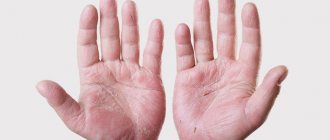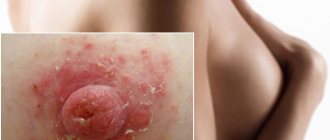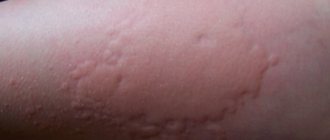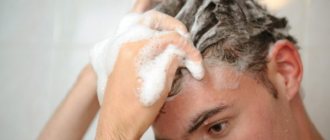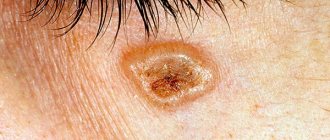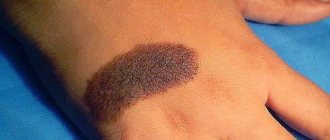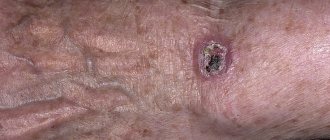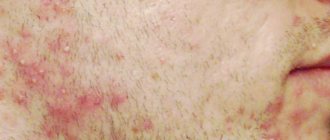Main external reasons
External causes of dry skin include:
- wearing synthetic items (socks, tights, stockings);
- constrictive clothing and shoes;
- oversaturation with sunlight;
- use of cosmetics with a high content of alkalis;
- influence of external aggressive environment (chlorine in the pool, ecology)
Clothing made from synthetic materials can irritate the skin of your feet. The heat exchange process of the skin may be disrupted. Another negative property of synthetics is static electricity. The harm it causes is based on a neuroreflex mechanism. Electricity directly irritates the weakly protected nerve endings of the dermis.
Tight clothing and shoes have a detrimental effect on blood circulation, disrupt the movement of lymph and blood in the tissues, which causes dry skin. If clothing is tight, it interferes with the normal ventilation of the skin, which leads to discomfort, burning, itching and redness. The skin is poorly moisturized and dries.
Tight clothes and shoes cause dry skin
The skin dries and ages when exposed to sunlight. They negatively affect elastin and collagen fibers. Under the influence of ultraviolet radiation, biochemical processes occur in the skin that cause its degeneration. These processes are called photoaging.
Cosmetics with a high alkaline content weaken the pH value of the skin. Trying to restore it, the dermis secretes skin lubricant, which reduces moisture. This destroys the barrier that holds water.
Alkaline cosmetics accelerate transdermal moisture loss. The consequence of this is premature aging. Plus, under the influence of alkali, the dermis is more susceptible to photoaging.
External causes of dry skin include high chlorine content in the pool. It leads to irritation, peeling, and a feeling of tightness. In addition, dry skin can be affected by hard water, which disrupts sebum production.
Another negative external factor is gas pollution in cities. Exhaust gases, penetrating into skin cells, destroy the epidermis, elastin and collagen fibers, activate free radicals, which leads to a decrease in skin elasticity and dryness.
Causes of peeling feet
Dryness and cracks on the feet and heels look unsightly. If this is only an aesthetic problem, peeling or a visit to the pedicure salon will solve it.
But sometimes ordinary care does not help, because the reasons why heels peel can be more serious. Therefore, if problems do not go away on their own over time despite proper skin care, consult a doctor.
Changes associated with age
With age, the number of sebaceous and sweat glands decreases, and the skin's ability to produce sweat and lipids decreases. The amount of water in the skin, its ability to retain moisture, is also reduced.
These factors lead to dryness, which in turn contributes to skin aging - another reason why the skin on the soles of your feet peels.
Unbalanced diet
Like any other organ, skin requires a number of important nutrients to function properly. These include unsaturated fatty acids and vitamins. Their disadvantages include causes of dryness, cracking of the sole of the foot.
Infectious and somatic diseases
Dry skin, medically referred to as “xerosis,” is a broader classification that includes dryness, regardless of cause (both internal and external factors apply).
But there are a number of diseases that lead to dry, peeling, cracking heels.
They include the following diseases:
- Atopic eczema often affects young children and is accompanied by rough, irritated skin on the feet, heels, back of the knees, inside of the elbows, and around the thighs. The affected areas are very itchy. The disease also occurs in adults.
- Psoriasis often forms dry, hard and itchy deposits on the feet and other parts of the body.
- Type 1 and type 2 diabetes are another cause of dry, flaky skin on the legs, particularly on the feet and heels.
If the skin on your heel or toes is dry, cracked, or scaly, this may be a sign of thyroid problems. This organ produces hormones that control metabolic rate, blood pressure, tissue growth, and nervous system function.
Of course, the skin on the feet and heels can peel and crack due to less serious problems. Sometimes it dries out due to weather changes. But if, in addition to cracked heels, you experience weight gain, numbness in the legs, or blurred vision, consult a doctor!
External irritants
The reasons why the skin on the toes and heels peel off are varied - from poor cosmetic care and environmental factors to health problems. These reasons are influenced by internal and external factors.
External factors include, first of all, dehydration - a process that occurs in stages:
- The skin becomes dehydrated , loses natural lipids, which disrupts its protective barrier and ability to retain moisture.
- Insufficient skin hydration causes dehydration of its upper layers.
- Depending on the degree of dehydration, the skin becomes rough, scaly, prone to itching and cracking.
External causes that increase dehydration may include climatic conditions that affect its ability to retain moisture, as well as the use of inappropriate cosmetics.
The reasons why the skin on the toes and heels peels is due to environmental influences:
- Unfavorable climatic conditions - hot, cold, dry air (damage to the barrier function of the skin).
- Seasonal Changes – Worsening of cracked feet often worsens in winter or summer.
- Ultraviolet (UV) radiation can cause premature aging of the skin. She becomes more prone to dehydration.
Care for feet and heels:
- Frequent washing , long and hot baths deprive the skin of lipids that form its barrier.
- Incorrect regular care – you need regular care, using products for dry skin. It is especially important not to use aggressive detergents that destroy natural lipids.
The root cause is fungus
Fungal infection is the most common reason why the skin on the feet and heels peels. In the absence of other problems, such as itching, burning, suspicion of a fungus often does not arise. This is mistake.
With insufficient treatment, the infection can affect the nails, thereby complicating treatment.
Main internal reasons
The skin of the feet dries out for the following internal reasons:
- diseases;
- problems with blood supply;
- lack of minerals and vitamins;
- age-related changes.
Dryness can be a sign of psoriasis, eczema, diabetes, and fungal infections.
Failures in the blood supply lead to a lack of oxygen, nutrients, and fluid in the tissues. Without receiving these components in the required quantity, the skin dries out.
The reasons for this phenomenon may be related to a lack of vitamins. The main vitamins for combating dry skin are:
- retinol (vitamin A);
- tocopherol (vitamin E);
- B vitamins;
- ascorbic acid (vitamin C);
- biotin (vitamin H).
They moisturize the skin and form new cells. Age-related dry skin is associated with hormonal changes in the body. New cells form more slowly, and old ones do not have time to transform.
Why does the skin on my legs above the knees peel?
- improper care: after a daily shower, we are often too lazy to pay attention to our feet, limiting ourselves to applying cream to our face. Therefore, you should not be surprised if floor-length skirts will soon appear in your wardrobe. However, if you regularly use Panthenol EVO milk with 2% Dexpanthenol and vitamin E, then you will not have to hide your beauty, and your skin will remain soft at any time of the year.
- Hives often occur during pregnancy. In this case, any relief of symptoms should only occur after consultation with a doctor;
- neurosis;
- allergic reactions. It is common knowledge that sometimes after drinking a glass of multi-colored cocktail at a party or after trying a new masterpiece of culinary art in a restaurant, a terrible itch occurs. It is very important not to scratch the problem area. It is better to try to fix the problem by applying a little body milk.
Dryness and flaking
The skin on the legs becomes dry and flaky for the following reasons:
- Allergy. An allergen can be a food product, clothing material, dust, or pet hair. If possible, avoid irritants and take antihistamines.
- Stress and overwork lead to the release of cortisol. It changes collagen molecules, which leads to dry and flaky skin.
- External aggressive environment (chlorine in the pool, ecology, ultraviolet radiation).
- Age-related and hormonal imbalances in the body appear after 50 years, which causes dry skin. This happens due to changes in the structure of collagen fibers, which primarily form the epidermis. It is recommended to eat more foods containing collagen and drink clean water to support fat and lipid metabolism.
- Fungal infections that lead to skin irritation and changes in its structure.
In older people, all causes become more acute.
Recognition of the disease and the principle of treatment
The factors described above that cause peeling of the skin on the soles of the feet confirm that such a phenomenon may indicate the development of a serious pathological process in the body. Therefore, it cannot be ignored.
First of all, you need to contact a dermatologist to determine the causes of what is happening and, if necessary, carry out a differential diagnosis. First of all, the doctor conducts an examination, excluding a number of pathologies, after which a mandatory set of tests - blood and urine.
If a fungal infection is suspected, a scraping is additionally taken from the affected area. If necessary, specialists may be involved to make a correct diagnosis.
Therapy is selected based on the specific situation. When choosing medications, the diagnosis, age of the patient, the presence of concomitant diseases, contraindications and a number of other factors that can affect the treatment process are taken into account.
Correct treatment can only be prescribed by a medical specialist based on medical history and additional research.
Dry and itchy feet
Dry and itchy skin on the legs can occur due to a number of diseases: rubella, chicken pox, measles.
Causes of itching:
- Itchy feet can be caused by allergies, such as hives. Another cause of itchy skin on the legs is excess glucose levels in diabetes mellitus.
- With liver diseases, itching of the lower extremities appears. This occurs due to the release of bile into the blood, which affects the nerve endings.
- Impaired blood supply is the cause of itching, accompanied by swelling and heaviness. Acute itching that occurs on the foot and between the toes may be due to a fungal infection.
Treatment of dry feet
Often, excessive dryness of the feet is the first sign of a developing pathology in the body, so if the problem persists, you should definitely seek help from a doctor who, depending on the diagnostic data, may prescribe:
- Taking complexes of vitamins and minerals if a decrease/weakening of immunity or a lack of certain substances in the body is detected.
- Insulin in tablets or injections, which solves endocrine problems - in particular, dry feet can be caused by diabetes.
- Complex use of external remedies for psoriasis, dermatitis, eczema and other dermatological diseases.
Full treatment will not work unless the diet is corrected. Experts will immediately give recommendations regarding the inclusion of vegetables, fruits, bird liver, fatty sea fish, and nuts in the menu. These products contain most of the vitamins and minerals that are responsible for the water balance in the body and, in particular, on the skin.
We recommend reading about paraffin baths for hands and feet. From the article you will learn about the principle of action of paraffin baths, their benefits for the skin of the hands and feet, and recipes at home. Read more about the exfoliating foot mask here.
The skin of the feet needs the same constant and careful care as any other part of the body. Beautiful and moisturized legs will give self-confidence to every woman. Particular attention to this area should be paid to ladies after 40, then the gait will always be light and flying.
Dry skin on feet
Dry skin on the feet is often caused by walking without shoes in the summer. This may be accompanied by the appearance of a fungal infection. One of the main reasons is uncomfortable shoes made from non-natural materials, so the skin does not breathe.
Dry skin on the legs. The reasons may be the appearance of a fungus. It occurs when wearing uncomfortable shoes that do not breathe. It is important to choose quality shoes
This is aggravated by the special skin of the sole, which is thicker than in other areas. Inflammation and cracks can result from insufficient care of the skin of the feet.
Causes of dry skin on the feet, cracks
Everyone knows that the appearance of the epidermis reflects the internal state of the body. Dry foot skin is an indicator of many problems. This is not just a cosmetic flaw. There are many reasons for the appearance of dryness and flaking - from the characteristics of the body to diseases. Thus, tightness and cracks in the skin of the legs can be caused by:
- External exposure: due to walking on hot sand at the beach or staying indoors with extremely dry air, as well as open sandals in summer.
- Wearing tight, comfortable shoes, which impairs blood circulation in the tissues.
- Constant contact with detergents containing a lot of alkali.
- Too tight and thick socks, tights, leggings.
- As a result of being in the cold, when blood circulation is again impaired.
- Frequent hair removal, especially without subsequent moisturizing and treating the skin.
- Hard and chlorinated tap water.
- Over 40 years of age, as gradually the amount of hyaluronic acid, elastin and collagen is produced less and less. The skin becomes thinner and cannot moisturize on its own.
- Diabetes mellitus.
- Skin diseases such as psoriasis, dermatitis, eczema.
- Deficiency of vitamins and microelements.
- Disturbances in the functioning of the thyroid gland.
- Metabolic disorders.
Of course, you shouldn’t panic and think that dry skin on your feet indicates serious illness. Each ailment has a number of direct signs, and tightness of the epidermis on the legs can act as an additional symptom or as a consequence. On the other hand, it is worth thinking about the state of your health if such a problem is constantly present. It is possible that it will be possible to prevent the development of a dangerous disease at an early stage.
Expert opinion
Tatyana Somoilova
Cosmetology expert
Also, often dry skin on the feet is the result of a negligent attitude towards oneself and one’s appearance. This is especially true for people over 40 - 45 years old. Insufficient skin care provokes violations in the integrity of the integument. The older a person gets, the more careful self-care should be. Now you can’t do without special procedures and means.
Dry skin on toes: causes
Dry skin on the toes may result from:
- wearing synthetic clothing - tights, socks made of synthetic or woolen materials serve as a strong irritant;
- tight shoes, rubber soles/boots, the use of artificial materials in the manufacture of shoes - blood circulation is impaired;
- using regular soap for foot hygiene;
- ignoring the need to moisturize the skin of the feet and toes.
Toes can actively dry out at the age of 40 years and older - this is a natural phenomenon that is associated with the aging of the epidermis and the entire body as a whole.
Dermatologists separately consider fungal diseases - most often they cause excessive dryness of the fingers on the lower extremities. This may be the first sign of a developing pathology; later other, more pronounced symptoms will be added to it.
If the skin on your legs is dry and itchy in winter
If in winter the skin on your legs becomes excessively dry and itchy, then you first need to rule out a fungal disease. Next, it’s worth reviewing the algorithms for performing hygiene procedures, because foot care continues regardless of the time of year:
- washing feet using soft gels;
- weekly skin scrubbing;
- use of moisturizing creams.
Itching on dry skin is a sign of irritation; you need to look for a provoking factor: staying indoors for a long time in winter shoes, excessive sweating of the feet, wearing low-quality shoes, synthetic socks, and so on.
Dry and itchy feet
If your feet itch and dry at any time of the year, you will need the help of a dermatologist - most likely a fungal disease will be diagnosed. You can become infected with it on the beach and in a bathhouse, swimming pool, walking barefoot on the floor, or wearing open shoes. The fungus can occur in different stages, but its symptoms most often are:
- excessive dryness of the feet and toes of the lower extremities;
- itching – often unbearable;
- the appearance of weeping lesions - especially often observed in the space between the fingers;
- presence of small rashes;
- burning in places of increased concentration of manifestations of fungal infection.
Only antimycotic (antifungal) therapy will help solve the problem, which is selected by the doctor depending on the type of fungus affecting the patient’s skin.
Dry skin on the foot near the bone
Near the bone (the area of the first/thumb or ankle), the skin may dry out due to:
- wearing too tight, narrow shoes;
- the use of low-quality clothing made from synthetic materials;
- development of fungal diseases;
- progression of psoriasis;
- insufficient intake of vitamins into the body.
The problem can be solved by getting rid of provoking factors, at the same time taking vitamin complexes and carrying out hygienic and caring procedures strictly in accordance with the recommendations of a dermatologist.
Dry skin anywhere on the legs can be associated with poor nutrition - too strict a diet or, on the contrary, eating only harmful foods leads to metabolic disorders; insufficient oxygen and vitamins/minerals are supplied to the cells of the organs and skin, which is a provoking factor.
Causes of cracks
The appearance of cracks in the skin of the lower extremities is influenced by:
- Summer footwear. When wearing slates, the sole of the foot may receive impacts and microtraumas. Dry air and hot sand can also have a detrimental effect.
- Uncomfortable shoes and synthetic socks. When using them, the soles of the feet dry out and become cracked.
- Insufficient foot care. You should use baths and remove keratinized epidermis.
- Fungal infections. They are eliminated with antifungal drugs. Shoes should be disinfected.
- Kidney diseases and endocrine disorders.
- Disorders and diseases of the gastrointestinal tract.
To completely cure cracks, it is necessary to find out the cause and take preventive measures.
Dry spots on the skin of the legs
Dry spots on the skin of the legs are formed due to a disruption in the functioning of the sebaceous and fatty glands.
This is influenced by factors:
- Allergies to food, medications and other substances (detergents and cosmetics).
- Diseases of the gastrointestinal tract.
- Fungus and similar diseases (various types of lichen).
- Skin disease such as eczema, psoriasis and others.
- Stressful state.
Dry spots also appear due to fluid deficiency and liver dysfunction.
Signs of the disease
Along with dry skin on your feet, other symptoms may appear:
- Separation of a layer of skin due to fungal infections.
- Dermis flows between the fingers.
- Bubbles appear, burst and dry out.
- Acute peeling.
- Psoriatic arthritis.
- A papular rash occurs between remissions.
- There is an irregular structure of the nails.
- Change in color of the dermis.
- Hard nodules form.
The listed symptoms relate to diseases: psoriasis, eczema, mycosis.
Cosmetics for the skin of the feet
Cream "Zorka"
It contains: chamomile extract; vitamins A, E; glycerol. The cream neutralizes inflammation, bacteria, moisturizes and nourishes the skin.
Apply at night on clean feet. It is advisable to wear cotton socks. Frequency of use: 1 time every 3 days.
Cream “Forest Power”
Ingredients: sorbic acid, flavorings, petroleum jelly, floralisin. The cream delivers oxygen to the cells of the dermis, nourishes it, and restores collagen tissue. The product is rubbed into the skin of the feet using massage movements. The procedure is repeated 2 times a day.
Cream “Lekar” with urea
Contains: urea, celandine extract, allantoin, oak bark extract, vitamin E, tea tree essential oil.
The drug softens the dermis of the heels and feet, and eliminates dried calluses. Rub onto clean, dry skin before bed once a day.
Cream "Sesderma"
Ingredients: oat extract, urea. It has a moisturizing, cleansing, soothing effect on the skin and eliminates itching. The cream should be rubbed in morning and evening, massaging problem areas until completely absorbed.
Therapeutic foot baths
Sea salt bath
Ingredients: warm water, one and a half tablespoons of salt. Dissolve the salt and place your feet in the water for 15 minutes. Then wash off the salt with water and moisturize the skin with cream. It is not recommended to continue the procedure longer, as salt corrodes the dermis.
Red wine bath
Ingredients: water (2 l), red wine (500 ml). After mixing, keep your feet there for 20 minutes. Wipe your feet and apply cream. The bath can be taken once a week.
Bath with medicinal herbs
Ingredients: wormwood, chamomile, mint, calendula, lemon balm. Pour hot water over the herbs and leave for 30 minutes. Keep your legs in the pelvis for no more than 20 minutes. After wiping them, moisten them with cream.
Baking soda and soap bath
Ingredients: baking soda (14 gr.), 15 gr. soap shavings. Stir in water at room temperature. The procedure lasts no more than 15 minutes.
Upon completion, the feet are rinsed with clean water and moisturized with cream.
Treatment methods
Instructions for using Keto Plus shampoo and cheap analogues
To get rid of peeling skin on your feet, you first need to eliminate the source of the problem. If an external factor can be excluded independently, then internal problems require a comprehensive diagnosis.
If the cause is a disease that affects the skin, medical correction through medications is necessary. The choice of medications is determined by the specific disease.
As an auxiliary method, you can use cosmetics and traditional medicine recipes, which can speed up the healing process and restore damaged epidermis.
Nourishing and softening creams
Such topical agents have proven themselves well - cream Ballet, “Instant Effect” and Belita based on an extract from calendula and celandine inflorescences. They can be used to treat your feet at home; no doctor’s consultation is required.
Brief characteristics of nourishing and moisturizing creams:
- Ballet is a natural moisturizer. The composition includes an extract of oak bark, wormwood, and horse chestnut. Effectively softens the skin, replenishes moisture deficiency, and protects from drying out. The cream promotes the healing of small cracks and stimulates blood circulation.
- The “Instant Effect” product eliminates peeling, relieves dry feet, and nourishes the skin. The composition includes a lot of vitamins, St. John's wort and sage extract.
- Cream "Extra" returns the natural appearance of the skin. Has antiseptic properties. Can be used as a prophylaxis against fungal diseases.
The described products will help restore a healthy appearance to the skin, relieve flaking, excessive dryness and tightness. Apply every day after a foot bath, applied exclusively to a dry surface.
Note: if the cause lies in a fungal infection, then the use of specialized drugs with antimycotic properties is required. For example, Clotrimazole, Ketoconazole.
Traditional medicine recipes
In alternative medicine there are many methods that combat dry skin of any location. These methods will help in situations where the cause is an external factor - uncomfortable shoes, synthetic socks, etc.
Boric acid: use of powder, soap and alcohol solution
If you have dry skin on your feet, you can use the following recipes:
- Apple based mask. Grate one green apple with its peel on a fine grater, transfer the mixture to gauze, and apply it in this form on the soles of your feet. Wear warm socks on top. Leave the mask on all night. In the morning, the compress is removed and water procedures are performed. Rub in moisturizer. The procedure is repeated 3-4 times a week, the recovery course varies depending on the complexity of the problem;
- Mask based on castor oil. Heat the oil in a water bath until slightly warm. Pour into a flat container and place your feet on it. The manipulation lasts for 20 minutes. Afterwards, rub the remaining oil into the heels with your hands. Remains of the product are removed with napkins. Put on socks. Repeat several times a week;
- Grate 2 potatoes, add the same amount of flax seeds and plain water. Place on low heat and simmer until the ingredients thicken. Apply the product at room temperature to the lower limbs and leave for twenty minutes. Rinse off the mask with warm running water.
When choosing a recipe, it is necessary to take into account the individual characteristics of the body. Folk remedies help some people in 2-3 procedures, while others need recovery within several weeks.
Foot baths
Foot baths help get rid of excessive dryness. Medicinal plants that have antiseptic, anti-inflammatory and disinfectant effects are usually used.
Several recipes:
- Two tablespoons of chamomile per 1 liter of water. Leave for 20 minutes, pour into a bowl of water, and lower the lower limbs. The manipulation time is 10-15 minutes, after which the feet are wiped and cream is applied.
- Take hot water into a container, add 2 tablespoons of calendula inflorescences, 1 tablespoon of sage. Leave for 10 minutes. Immerse your feet in the water for 20 minutes. Repeat every other day.
At home, you can make baths based on string, resin, plantain and other medicinal plants. After the water procedure, always use cream.
Streamlining your diet for healthy skin
To maintain healthy skin, the following foods should be present in your diet:
- Fruits and vegetables are orange in color. For example: persimmons, carrots, peaches, pumpkin, apricots. They contain vitamin A, which is necessary for skin cell renewal.
- Citrus fruits containing vitamin C. It promotes collagen formation for proper skin pigmentation and is a strong antioxidant.
- Lettuce and spinach. Vegetables are beneficial for the skin because they contain vitamins A, C, B, E.
- Nuts. They are rich in B vitamins and useful elements such as potassium, cobalt, iron, magnesium, phosphorus, manganese. Thanks to them, fats and proteins are more efficiently synthesized in cells, and new dermal tissues are formed.
- Cereals. They contain B vitamins, proteins, zinc, silicon, selenium, cobalt, copper, potassium. Dietary fiber improves the functioning of the digestive system and removes waste and toxins from the body. Silicon increases turgor and elasticity of the dermis.
- Fermented milk products enhance intestinal motility and normalize its microflora.
- Iron-rich foods. Apples, pomegranates, blueberries, white beans, liver, red meats, seafood. Iron increases hemoglobin, which supplies oxygen to tissues, preventing the effects of toxins and skin aging.
- Omega fatty acids are found in fatty fish, vegetable oils, flax seeds, cod liver, and nuts. Restore the lipid layer that protects skin cells. Saturates the skin with moisture, making it elastic.
- Green tea , being a natural antioxidant, prevents skin aging.
Poor nutrition and fluid deficiency lead to depletion and dryness of the epidermis. Every adult needs to drink at least 2 liters. water per day.
Vitamin complexes
- "Perfectil" . Ingredients: almost all vitamins, copper, biotin, selenium, zinc. The drug counteracts skin aging. Take 1 capsule after meals per day for a month. Between courses there are intervals of 1-2 months.
- "Vitrum Beauty" . Ingredients: vitamins A, D, E, C, B, folic acid, nicotinamide, rutin. Microelements: iodine, iron, manganese, calcium, selenium, boron, zinc, magnesium. The drug restores and strengthens the structure of the dermis. The complex is taken 2 tablets per day after meals. It is possible to increase the dose to 3 tablets.
- "Supradin" . Ingredients: vitamin A, D, E, PP, H, sodium bicarbonate, sucrose, sodium saccharin, mannitol, lemon flavor, tartaric acid. “Supradin” improves the efficiency of metabolic processes and promotes the synthesis of the collagen layer of the skin. The drug is taken 1 tablet with meals 1 time per day. The course lasts 30 days, after which there is a break for a period of 60 to 90 days.
Recipes for medicinal compositions for skin
Moisturizing peeling mask
You will need oatmeal (3-4 tablespoons), sugar, honey, 2 tablespoons of cosmetic oil. spoons. The flakes are ground in a coffee grinder. The remaining components are added and mixed to a dense mass.
Rub the product onto pre-steamed feet using massaging movements and leave on for several minutes. Rinse the mixture with water and apply cream. You can make a mask every day.
Nourishing softening mask
Ingredients: honey, sour cream, full-fat cottage cheese. 2 tbsp. tablespoons of cottage cheese are mixed with sour cream and honey (1 tablespoon each). Rub the mixture into the skin of your feet and leave for 40 minutes. Rinse and moisturize the skin with cream. Repeat the procedure 2-3 times a week.
Mask for exfoliating old cells
Ingredients: oat flour, chopped nuts, sour cream. Flour (3 tablespoons) is thoroughly mixed with nuts (1 tablespoon), sour cream is added, everything is mixed until smooth. Apply to feet and leave for 20 minutes. After this, rinse your feet with clean water, rub your feet with a file and apply cream.
Prevention and foot care
In cases where the disease is not diagnosed and flaky skin is a consequence of dryness, hypothermia, or walking in poor-quality shoes, you can follow some simple rules to keep your feet in proper condition. It is worth noting that if they are systematically followed (regardless of the presence of peeling on the feet), you can completely get rid of this problem.
At home, it is recommended to perform the following procedures to restore, nourish and moisturize the skin on the feet:
- Apply cakes with honey to the skin of your feet before going to bed. To prepare them, you will need to knead the dough with your hands from 1.5 tablespoons of honey and 2.5 tablespoons of wheat flour. The composition is divided into 2 equal pieces and flat cakes are made. Then the legs are steamed, the dough is applied, cellophane is wrapped on top and socks are put on. After 7 days of constant use of this product, peeling is eliminated, and the skin becomes a healthy pink hue.
- Use healing baths with apple cider vinegar. This remedy helps eliminate fungal infections and quickly heal wounds. Vinegar is mixed with water in equal proportions. The feet are lowered into the resulting liquid and left for 15 minutes. Then the feet are treated with a nourishing cream, and socks are put on top. In the morning, keratinized skin is removed with a simple pumice stone.
- You can use homemade ointments. For the treatment of cracks and peeling, a potion is suitable, for the manufacture of which 1 raw yolk, 1 tbsp. a spoonful of sunflower oil and a teaspoon of vinegar. The components are mixed with a mixer until a creamy mass is obtained and applied to the steamed legs. Socks made of cotton fabric are put on top.
- Be sure to remove dead skin every day while taking a bath at night using a pumice stone or a special file.
- After taking a bath or shower, your feet should be carefully dried with a terry towel.
- Every day before going to bed, you need to lubricate your feet with a nourishing and moisturizing cream.
In addition, do not forget that the quality of skin depends on a person’s diet. It may be necessary to revise it and introduce large quantities of vegetables, fruits, meat and fish into it.
To prevent the formation of peeling skin on the feet, you should adhere to the following preventive measures:
- wear only high-quality clothes and shoes;
- periodically use a special nourishing and moisturizing foot cream;
- choose your shower products carefully;
- maintain an active lifestyle;
- do gymnastic exercises to strengthen the leg muscles;
- drink at least 2 liters of water daily;
- eat fish high in amino acids;
- if possible, reduce the heating in the rooms to 20-22o to ensure a comfortable stay in them;
- additionally humidify the air using a humidifier, or using a bowl of water placed on the radiator;
- You should not walk in cold weather in nylon tights.
It is necessary to exclude stressful situations or not to show a strong reaction. Due to stress, many pathologies may arise and the patient’s condition may worsen. Stress can cause peeling of the feet, hair loss, brittle nail plates, weight gain, and diabetes.
If you often find yourself in stressful situations, it is recommended to go in for sports. This helps eliminate bad mood and has a positive effect on the general condition of a person.
When it is discovered that home care cannot eliminate dry skin on the feet, and additional signs have appeared, you should seek the services of a specialist. There has probably been a disruption in the functioning of the body.
If you consult a doctor in a timely manner and follow all his prescriptions, you can avoid possible complications.
Nourishing oils and how to use them
- Shea butter (another name is “shea”) moisturizes the epithelium, softens and soothes the skin. Forms a protective layer of the dermis. Should be used before bed: rub in the oil and put on socks.
- Olive oil has a moisturizing effect due to its fatty acid content. Oleic acid promotes hydration and restores the outer layer of the epidermis. The oil is rubbed into the skin and stays on for 1 hour. Be sure to rinse with warm water, as cold water increases dryness of the skin.
- Coconut oil contains acids such as lauric, hyaluronic, more than 7 types of fatty acids, and their triglycerides. They moisturize the epithelium, heal cracks, destroy bacteria, preventing fungal diseases. Before going to bed, the oil is rubbed into the skin, after which it is treated with pumice. It is advisable to wear socks.
Dry skin on the legs, the causes of which are varied, can be eliminated on your own. Vitamin preparations, recipes for moisturizing and nourishing baths, and the use of oils will help with this. It is also important to remember that excessive dryness with other symptoms can be a sign of a developing disease.
What do experts recommend?
To prevent dry skin on the legs, dermatologists recommend regular pedicures and cleansing of the stratum corneum of the dermis. It is enough to steam your feet several times a week using a milling cutter or penza. After the procedure, you should use a moisturizer.
Advice! What to do if the skin peels, itches, turns red, and over time the nail plate becomes deformed? In this case, you should not self-medicate. It is necessary to be examined by a dermatologist for the presence of fungus.
If you have dry feet and hands, dull hair, brittle nails, you need to adjust your diet. To improve the condition of the dermis, use creams with vitamin A and E. Also in autumn and spring, take a complex of vitamins that improve immunity, eat fresh vegetables and fruits.
Peeling often occurs in women after depilation or hair removal. Therefore, during the procedure, special creams, wax with added oils, vitamins, and sugar paste are used. Finally, the skin is treated with a soothing and regenerating agent.
